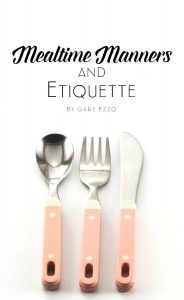What does dinner look like at your house? Are there manners or mayhem? Are your children refined or rude at the table? Is conversation gracious or graceless? And does it really matter anyway?
It does matter because embedded within mealtime etiquette are otherness virtues that intuitively resonate with people. People not only connect with the courtesy message, they also appreciate the messenger, even if the messenger is only a six-year-old child. Good manners will always minister grace and life. And that matters!
That conclusion leads to this warning: Parents who underestimate the profound influence that mealtime manners will have on their child are already taking a risk with their child’s future. Good manners will always give children an advantage in life, because people always respond positively to the well-mannered child. And some of those people will be people of influence.
Mealtime Basics: What Not To Do
The prohibitions contained in the list below are so common that you might actually hear your mother’s voice as you work through each item. The items on the list do not require a detailed explanation on our part, but they might require a greater explanation when teaching them to your children. As you begin to transfer these concepts, please remember to provide your children with the moral reason “why.” The moral reason “why” plays a significant role in the transmission of each courtesy because it helps children connect their behavior to a purpose and not simply to a prohibition. Thus, the simple instruction, “Elbows off the table,” will never be sufficient if your child does not know how his actions are tied back to the moral consideration of others. In this case, an elbow or elbows resting on the table while dining is viewed as poor manners for at least two reasons. First, to do so tends to bring the entire body closer to the table, potentially intruding on the space of those with whom the meal is being shared. Second, elbows on the table can also communicate boredom or detachment, especially in formal settings. To do so is construed as one being anti-social and unwilling to engage the moment, thus robbing others of the pleasure associated with the relational aspects of dining. However, elbows resting on the table after the meal, when lingering in conversation, is accepted as a comfortable conversational position, without a tinge of rudeness attached.
The final point to make before reviewing the list is to remind the reader that each prohibition has its own antonym, that is, a corresponding encouragement. For example, “Do not talk with your mouth full of food,” also implies, “Finish chewing your food thoroughly before speaking.” “Do not smack your food,” implies “Chew quietly with your mouth closed.” At some point in your training, courtesy prohibitions must be balanced with the expected behavior.
Each item on the list below is considered discourteous and requires Mom or Dad’s attention. Most can be handled with verbal reminders that continually point toward what a child should do and not simply what the child is doing wrong.
Instruct your child that it is impolite to:
- Chew his food with his mouth open, or talk with food in her mouth.
- Fill the mouth so full that the cheeks bulge while chewing.
- Spear large pieces of food with his fork, and then bite pieces off from the fork.
- Let any unpleasant sound leave her body, including sniffing, snorting, smacking, or loudly crunching food.
- Lean across the table or reach for an item that intrudes into the space of another person.
- Eat with his elbows on the table, or slump in her chair while at the table.
- Comment unfavorably about the food or table setting.
- Wave or point with a utensil.
- Continually get up and down from his chair while at the dinner table.
- Play with her food (especially when it’s been set apart by prayer).
- Take helpings so large that little to no food is left for others.
- Take food off of serving plates with his fingers.
- Make inappropriate hand gestures or use language that is inappropriate, or voice tones that are loud or disruptive.
- Ask a question to a person who is chewing food, or taking a drink of water, or talking to another person.
- Use her own silverware when taking food, instead of the serving utensils that belong with the food item.
- Snatch a food item from a serving plate or bread basket that is being passed to another person.
This list represents basic mealtime courtesies that, when in place, create an environment in which everyone feels comfortable, and consideration for others is given preeminence. Then mealtime can be enjoyed by all!
Excerpt from Parenting From the Tree of Life: Part Two by Gary and Anne Marie Ezzo





ContactMom.Life
Hi Paula,
Yes, you can contact us by clicking “Ask a Contact Mom” on our Home page. Thank you!